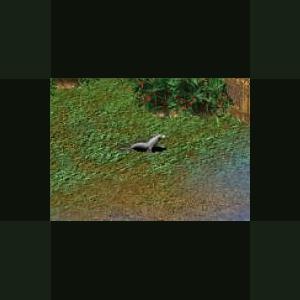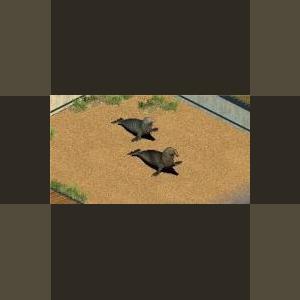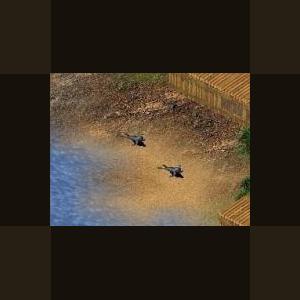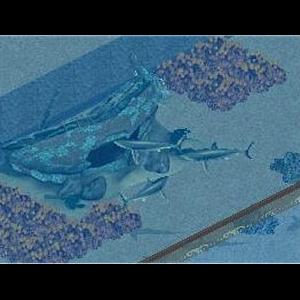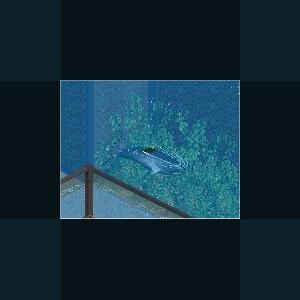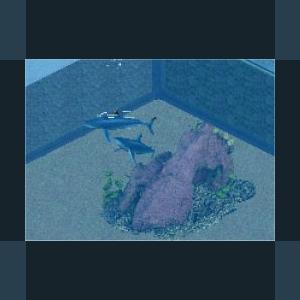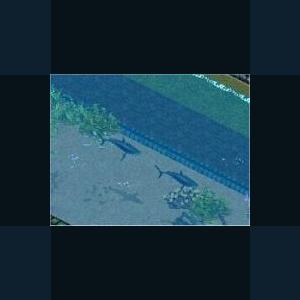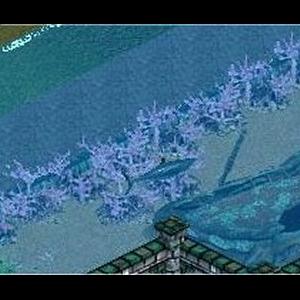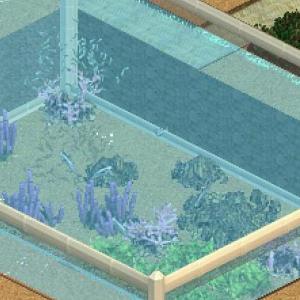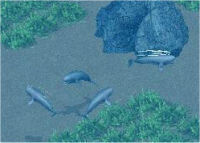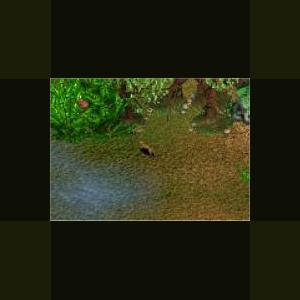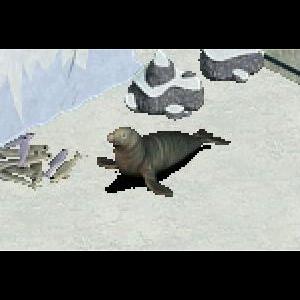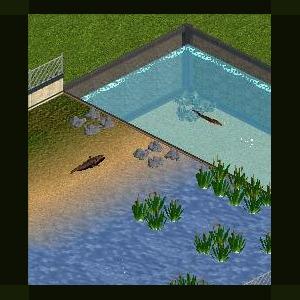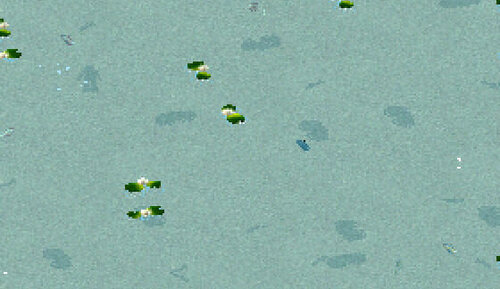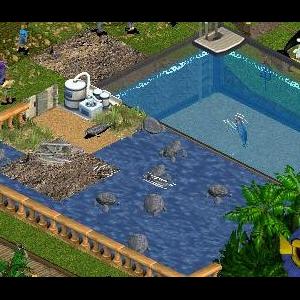Marine
Creatures under the sea
47 files
-
Nerpa Baikal Seal by Ghirin
By Guest
The nerpa or Lake Baikal seal (Pusa sibirica) is one of the smallest true seals in the world. This species of seal is native to Lake Baikal in Siberia and spends its entire life in freshwater.
297 downloads
0 comments
Updated
-
Hawaiian Monk Seal by Ghirin
By Guest
Hawaiian monk seals (Monochus schauinslandi) are found in the outer islands of the Hawaiian chain. Their genus, Monachus, is the only seal genus found in the tropics.
414 downloads
0 comments
Updated
-
Southern Elephant Seal by Ghirin
By Guest
The southern elephant seal (Mirounga leonina) is the largest living species of pinniped. This large seal is native to the sub-antarctic region.Elephant seals feed on fish and squid. They are know for their long, deep dives in search of prey.
451 downloads
0 comments
Updated
-
Caspian Seal by Ghirin
By Guest
The Caspian seal (Pusa caspica) is one of the smallest true seals in the world. It is native to the brackish waters of the Caspian Sea.
The Caspian seal is thought to be derived from the ringed seal of the Arctic and is close relative of the Siberian nerpa.
References:
http://en.wikipedia.org/wiki/Caspian_Seal
http://www.caspianenvironment.org/biodb/eng/mammals/Phoca%20(Pusa)%20caspica/main.htm
Created by Ghirin 2008
447 downloads
0 comments
Updated
-
Sicklefin Lemon Shark by Ghirin
By Guest
Sicklefin Lemon Shark Author: Ghirin
The sicklefin lemon shark (Negaprion acutidens) is a close relative of the lemon shark. The primary differences between the species are geographic location and fin shape. Sicklefin lemon sharks are native to the Pacific Ocean and their pectoral fins are more curved.
References:
Sharks, Ferrari and Ferrari. 2002
Ghirin 2005
284 downloads
0 comments
Updated
-
Lemon Shark by Ghirin
By Guest
Lemon Shark Author: Ghirin
The lemon shark (Negaprion brevirostris) is a large shark that inhabits the coastal waters of the Atlantic ocean, primary the coasts of the Americas and western Africa. A second population is also found in the Pacific coastal waters off of North and South America.
Lemon sharks form loose, same-sex groups that may come inshore during the day, but usually return to deeper waters at night. They are often found near the bottoms of of the bodies of water where they feed on bony fishes and crustaceans.
This species of shark is viviparous, giving birth to live pups (litter size ranges 4-17 pups). The pups live in shallow waters for the first years before venturing out into deeper waters.
*Inspired by the Zoo Tycoons Brains Trust at the Zoo Tek Forums
Created by Ghirin 2004
380 downloads
0 comments
Updated
-
Shortfinned Pilot Whale by Ghirin
By Guest
Short-finned Pilot Whale by Ghirin
The short-finned pilot whale (Globicephala macrorhynchus) is a large member of the dolphin family.
It is extremely social and usually travels in large groups.
References:
http://www.acsonline.org/factpack/PilotWhale.htm
www.wikipedia.org
*Inspired by the Zoo Tycoon Brains Trust at the Zoo Tek Forums*
480 downloads
0 comments
Updated
-
Porbeagle by Ghirin
By Guest
Porbeagle Shark Author: Ghirin
http://www.zoo-tek.com/forums/index.php?download=142
The porbeagle (Lamna nasus), also known as the Atlantic mackerel shark and bluedog, is a member of the mackerel shark family. It has the characteristic spindle-shaped body of its close relatives, the shortfin mako and the salmon shark, but has a slightly longer, more conical snout. The dorsal surface of this shark ranges from dark blue to gray and the belly is often white, but this varies by population.
Porbeagles have two distinct populations: A population that dwells in the North Atlantic and a second population that lives in the southern portions of the Pacific, Atlantic, and Indian Oceans. They are mainly found in open ocean, but can also be found in coastal waters.
Unlike most fish, the porbeagle and its close relatives have the ability to retain heat produced by metabolism. Special vascular structures known as retia mirabilia serve as counter-current heat exchangers between the muscles and viscera. The porbeagle can also alter blood flow, giving the shark more control over its body temperature and allowing it to raise its body temperature 12 degrees F above the surrounding water. This gives the porbeagle the ability to be a fast swimmer.
Porbeagles feed on a variety of bony fishes and will eat cephalopods when available. They are ovoviviparous and usually have litters of 1 to 6 pups with 4 being the most common.
*Inspired by the Zoo Tycoon Brains Trust at the Zoo Tek Forums
Created by Ghirin 2004
323 downloads
0 comments
Updated
-
Dusky Shark by Ghirin
By Guest
Dusky Shark Author: Ghirin
The dusky shark (Carcharhinus obscurus) has a wide distribution among the coastlines of temperate and tropical regions, with major populations found in the western Atlantic Ocean, western Indian Ocean, Mediterranean Sea, Pacific coast, and Australian waters. This shark prefers the relatively shallow waters of continental shelves. Young dusky sharks may congregate in bays and estuaries; however, adult dusky sharks avoid areas of low salinity. Dusky sharks are highly migratory. The exact path of migration varies with specific shark populations and is seasonal in nature.
Dusky sharks prey on bottom-dwelling fish and invertebrates (i.e., skates, crabs, flatfish). They will also feed on pelagic fishes. Dusky sharks are viviparous with litter sizes ranging from 3 to 14 pups.
*Inspired by the Zoo Tycoon Brains Trust at the Zoo Tek Forums.
Created by Ghirin 2004
383 downloads
0 comments
Updated
-
Saltwater Bull Shark by Ghirin
By Guest
Saltwater Bull Shark
Author: Ghirin
The bull shark (Carcharhinus leucas) is a large, robust shark found in shallow coastal marine waters worldwide. These sharks will also enter and live in estuaries, freshwater lakes and rivers.
Bull sharks eat both bony fishes and small sharks. In the cooler portions of their range, bull sharks mate during the summer months; however, in the warmer parts of their range they may breed year-round. Females nourish the young internally for 10 to 11 months and give birth to free-swimming pups.
*Inspired by the Zoo Tycoon Brains Trust at the Zoo Tek Forums.
Created by Ghirin 2004
377 downloads
0 comments
Updated
-
Silver Carp by Ryno
By Guest
The silver carp (Hypophthalmichthys molitrix) is a species of freshwater cyprinid fish
351 downloads
0 comments
Updated
-
Finless Porpoise by Ghirin
By Guest
Finless Porpoise Author: Ghirin
The finless porpoise (Neophocaena phocaenoides) is found in the costal waters from the Persian Gulf to Japan. Populations are also found in adjacent estuaries, rivers, and shallow channels. They prefer shallow waters (up to 50 m deep) with soft or sandy bottoms.
Due to its lack of a dorsal fine, it is easy to identify in the wild. The living animal is often blue-gray and may darken after death. The neck vertebrae are not fused, allowing the animal to turn its head. Males may grow to 2 m and females range up to 1.5 m in length.
Finless porpoises often seen in singly or in groups of 2-4. Large groupings of up to 20 have been reported. Their primary diet consists of small fish, squid, crustaceans, and octopus.
Created by Ghirin 2003
415 downloads
0 comments
Updated
-
Otter Civet by Ghirin
By Guest
Otter Civet
Author: Ghirin
The otter civet (Cynogale bennettii) resides in swampy wetlands and borders of streams and rivers in tropical southeast Asia and Indonesia. It is semi-aquatic and resembles a small sea otter. The civet otter is thought to ambush small mammals and birds when they come to the water to drink; it may also eat crustaceans, mollusks, fish and fruit.
References:
Walker’s Mammals of the World. Nowak, 1999
Created by Ghirin 2003
387 downloads
0 comments
Updated
-
Crabeater Seal by Ghirin
By Guest
Crabeater Seal by Ghirin
The crabeater seal (Lobodon carcinophagus) is one of the most common large mammals in Antartica.
It is known for its complicated tooth pattern which forms an interlocking sieve for filtering krill.
Crabeater seals usually haul out on the pack ice, but have also been known to travel inland.
*Inspired by Professor Paul's Nature Encyclopedia at the Zoo Tek Forums*
References:
http://en.wikipedia.org/wiki/Crabeater_Seal
http://www.antarcticconnection.com/antarct...crabeater.shtml
423 downloads
0 comments
Updated
-
Salmon Shark by Ghirin
By Guest
Salmon Shark
Author: Ghirin
The salmon shark (Lamna ditropis) is considered by many to the Pacific Ocean equivalent of the porbeagle. This shark has a similar build and shape as other members of the mackerel shark family. Like the mako, porbeagle and great white, the salmon shark is able to maintain it body temperature several degrees above the surrounding ocean.
This shark prefers the cooler waters of the northern Pacific Ocean and ranges from California to the coasts of South Korea. It is mainly pelagic in habitat but will travel in coastal and epipelagic regions of it range.
Salmon sharks may form schools, but the sexes do not school together. It is a fast swimmer. Its main diet is composed of a variety of fishes including salmon, herring, sardines, cod, and dogfish. They will also consume squid when available.
*Inspired by the Zoo Tycoons Brains Trust at the Zoo Tek Forums.
Created by Ghirin 2004
327 downloads
0 comments
Updated
-
0 comments
Submitted
-
Japanese Sea Lion by Coolperson5
By Guest
Japanese Sea Lion (Zalophus japonicus) is thought to have become extinct in the 1950s.
Prior to 2003 it was considered to be a subspecies of California Sea Lion as Zalophus californianus japonicus. However, it was subsequently reclassified as a separate species. Some taxonomists still consider it as a subspecies of the California Sea Lion. It has been argued that japonicus, californianus, and wollenbaeki are distinct species because of their distant habitation areas and behavioral differences.
They inhabited the Sea of Japan, especially around the coastal areas of the Japanese Archipelago and the Korean Peninsula. They generally bred on sandy beaches which were open and flat, but sometimes in rocky areas.
Currently, several stuffed specimens can be found in Japan and the National Museum of Natural History, Leiden, the Netherlands brought by Philipp Franz von Siebold. The British Museum possesses a pelt and 4 skull specimens.
427 downloads
0 comments
Updated
-
Trout Pack by Coolperson5
By Guest
A pack of freshwater trout.
This pack includes 5 species of freshwater trout.
Apache Trout
Bull Trout
Cutthroat Trout
Gila Trout
Golden Trout
Each fish needs a 5 square tank of any depth with 2 squares of water lilys and one square of rocks. The zookeeper will say that it needs a mate if it is alone, but it will not affect suitability or happiness.
Have Fun!
This file includes both Trout Pack_CP5Combined.ZTD, which is combined, and the 5 individual files. If the combined .ZTD is used, the others are not needed.
583 downloads
0 comments
Updated
-
Cuban Hog Fish by JT (JohnRN1)
By Cricket
Thank you for downloading the Cuban Hog Fish. This colorful saltwater fish was made for the 2012 Tek Anniversary. Congratulations Tek.
"Move the .ztd file into the dlupdate (and not dupdate) folder if one exists in your Zoo Tycoon folder; otherwise move the .ztd file into the Updates folder that is in the Zoo Tycoon folder."
The default is C:\Program Files\Microsoft Games\Zoo Tycoon
Thank you to Fern and Jay for their invaluable encouragement, guidance and expertise.
--JohnT--
360 downloads
0 comments
Updated
-
Habour (or Common) Seal by Tasmanian Tiger
By Fern
Harbour (or Common) Seal
Author : Taz (Tasmanian_tiger)
Category : Real animal, Pinniped
Updated: June 29, 2013 by Jay to correct 3 animation views, to remove unnecessary files and configuration lines, and to correct configuration mistakes done by the APE program, primarily related to animal behaviors and to sounds. Please note that the version at Taz's site is no longer the most current version, since she is deceased.
Current ztd date: June 29, 2013
Compatibility : All Game Versions
Description : The most widespread pinniped, the Common or Harbour Seal has a plump body and a small, cat-like head with a slight forehead and nostrils that form a V-shaped pattern. Its coat ranges from light to dark grey or brown, and has spots, rings and blotches all over. The breeding season varies regionally, and the pups are able to crawl and swim almost within an hour of birth. There are at least five subspecies of Common Seal. One of them, the Ungava Seal, lives in fresh water in N. Quebec, Canada. (Text by Dorling Kindersley Handbooks.)
481 downloads
0 comments
Updated
-
Vaquita (or Gulf of California Porpoise) by Tasmanian Tiger
By Fern
Vaquita (or Gulf of California Porpoise)
Author : Taz (Tasmanian_tiger)
Category : Tank animal, Critically endangered animal, Cetacean
Updated: July 26, 2013 by Jay to remove unnecessary files and configuration lines and to make some minor adjustments to the animal info.
Current ztd date: July 26, 2013
Compatibility : MM/CC
Description : The vaquita, or also called the 'Gulf of California Porpoise', is one of the smallest cetaceans around. It's about 1.5 meters or 5 feet long. Please note that the version at Taz's site is no longer the most current version, since she is deceased.
395 downloads
0 comments
Updated
-
Harp Seal by Tasmanian_tiger
By Fern
Author : Taz (Tasmanian_tiger)
Category : Real animal, Pinniped
Updated: September 25, 2013 by Jay to remove the background for the male and female animal list icons, to add an animal list icon for the young, to remove the top and bottom edges of the purchase menu icons, to adjust the positions of all animations, to make minor adjustments to the animal info, to add the preferred object tooltip for the female and young, to add the capability of a simple surface roll trick for show tanks, to add the capability to use 3 user made toys, to remove unnecessary files and configuration lines, and to correct configuration mistakes done by the APE program.
Current ztd date: September 25, 2013
Compatibility : All Game Versions
Description : The Harp Seal is somewhat larger than the Common Seal, growing to 5.5 ft (1.67 m) long and with a weight of 115-180 kg (253-400 lb). Males are distinctly larger than females. Harp Seals are well known for the saddle-like spot on their backs. Adult males are creamy white overall, with a dark chocolate brown head and a broad dark chocolate brown U-shaped pattern on their back, running across the shoulders and down each flank to near the base of the tail; the pattern is often slightly asymmetrical and irregular, with dark brown spots extending onto the white parts. Adult females have a similar but less distinct pattern, with the brown being paler and greyer. Immature Harp Seals up to two to three years old are pale grey, variably spotted with darker grey. The flippers are white or pale grey, with five stout claws on each fore flipper. The tail is short, 10-15 cm long. The fur on adults is 2 cm long, dense, stiff, and velvety; the skin is roughly the same color as the fur: whitish-grey under the white fur, and dark brown under the brown fur. The vibrissae are numerous on the muzzle, the longest about 12 cm long. The newborn pups are all white except for a black nose and eyes, which helps them blend in with the snow. Puberty is reached at 5-7 years, and the maximum lifespan is more than 30 years. Since newborn harp seals do not enter the water for a number of weeks, the young of this harp seal does not go in water. This Harp Seal can use the Ice Floe For Certain Animals By Taz, the Ice Floe For Certain Animals, and the Raft For Certain Animals. The Harp Seal is compatible with the Emperor Penguin, although the Emperor Penguin doesn't like it but will accept its presence and cause no problems. However, if the Emperor Penguin is in the same exhibit, then the exhibit must not have the Ice Floe For Certain Animals By Taz, the Ice Floe For Certain Animals, or the Raft For Certain Animals, since the penguin could get stuck on those toys, being that the penguin is not configured for those toys. The Harp Seal is also compatible with the Ribbon Seal made by Taz.
Note: ZT is not used to animals where the adults go in tanks while the young do not. So it can keep changing its mind between the exhibit being suitable and the exhibit needing more salt water terrain and less snow. Whenever it does change its mind and wants more salt water terrain, do so. Eventually it will get to a point where it does not change its mind.
520 downloads
0 comments
Submitted

